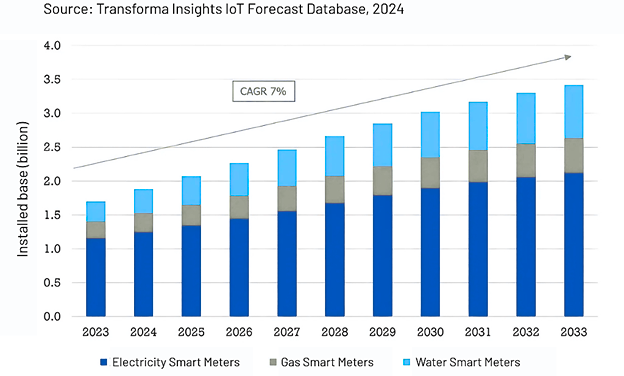May 22, 2025
Pressure to reduce energy consumption in the face of increasing costs and environmental impacts has led to utility companies across the world rolling out smart meters to help consumers and enterprise customers manage their consumption efficiently and gain a greater understanding of their usage profiles. With electricity grids transforming with the introduction of renewable energy generation, the home meter is now a two-way device to enable users to manage how they consume energy from the grid as well as keep track of how they contribute to the grid in the form of wind or solar power generation. For energy companies, smart meter information is no longer a billing tool but an essential enabler of efficient operations.
At the same time as transformation on the generation side, user demands have become more complex, with electric vehicle (EV) charging gaining popularity and putting greater demands on power infrastructures. Smart meters, especially those in the electricity sector, have a clear business case because they enable users to optimize their consumption via an app and select the most efficient times to utilize electricity. They can also track their usage and change their behaviours to save money and eliminate wasted consumption. Smart meters’ ability to communicate with the grid enables far more than simple, monthly counting of consumption and billing and to enable far richer information to be shared with power generators, utility providers and other systems.
Mass-scale metering
Smart meter roll-out is a big project. Analyst firm Transforma Insights has projected the number of smart meters deployed globally will grow from approximately 2.1 billion in 2025 to 3.4 billion in 2033[1]. The firm says that electricity smart meters will continue to dominate the smart metering market throughout its forecast period, accounting for over 60% of all meters.
Global smart meter forecast, 2023-33
[1] https://transformainsights.com/news/global-smart-meters-2033

Some countries have almost completed their smart meter deployments, notably many countries in the EU and China. In other regions there is still much to be done. By 2033, most of the work will have been done and the projected 1.9 billion residential smart meters will equate to a global household penetration of 81%.
Deployment challenges
There are a significant number of challenges facing smart meter deployments which necessitate careful consideration of how to develop, manufacture and deploy the hardware. Metering projects are typically led by utility companies which have often been required to roll-out smart meters by regulators and authorities in the nations they operate. These organizations need to develop devices that meet their criteria for communicating consumption data today but that also offer future-proof capabilities for the ten or 20-year lifespan of a utility meter.
The situation is further complicated by cost pressure, with meters needing to be highly cost efficient. Utility companies are faced with complex decisions regarding which communication technology to adopt, how to engineer devices to optimize performance and cost, and how to ensure compliance with regulation. In addition, manufacturing needs to scale up radically to meet the needs of mass-scale deployments and enable rapid installation.
Network selection
It is anticipated that more smart meters will adopt cellular technologies, such as LTE-M, LTE Cat 1 and LTE Cat 1 bis. These popular cellular technologies may be joined by 5G RedCap for use cases that require richer communication and NB-IoT for markets in which lower cost is required.
An original design manufacturer (ODM) can truly demonstrate its value here by handling all the cellular engineering required and advising on the best option for the deployment criteria. An essential element of smart meter design is to ensure longevity so the lifespan of the deployment can be maximized. This can mean two decades or more of active operation. ODMs have the experience across multiple technologies to help you select the best solution for your deployment. Finally, an ODM has the capabilities to develop relevant solutions to help customers and partners meet regulations and legislations across the globe. Compliance with these is an essential aspect of successful smart meter deployment and ODM capabilities can help OEMs in their preparations to meet market requirements.
The ODM approach
The core business and key focus of smart meter OEMs is to develop devices that help utilities’ customers optimize their consumption and receive a good customer experience. The smart meter OEM may only need a consumer-focused product design and engineering team for their smart meter project, once that’s complete, they won’t need the same resources so an appealing option for many smart meter OEMs is to adopt the ODM approach which enables them to pass selected parts of the smart meter hardware development and manufacturing process to a third-party organization.
The ODM can handle all or some of the aspects of the product’s development and manufacturing on their behalf. This approach can save cost, accelerate time-to-market and streamline regulatory approvals which can be mission critical for projects that have tight deadlines to complete roll-out.
Ikotek is a US-headquartered ODM that combines R&D resources across the globe with access to highly efficient, mass-scale manufacturing capacity. The sheer scale of smart meter projects is familiar territory for Ikotek, and our experience is ready to help you accelerate your smart meter project. To find out more about how we can help, visit www.ikotek.com

